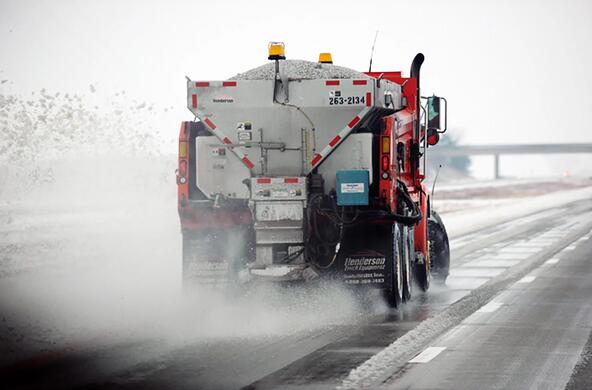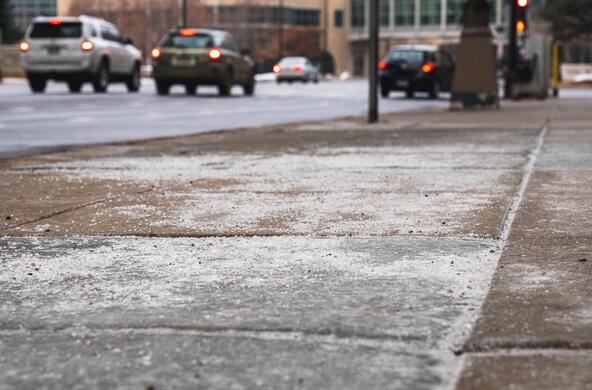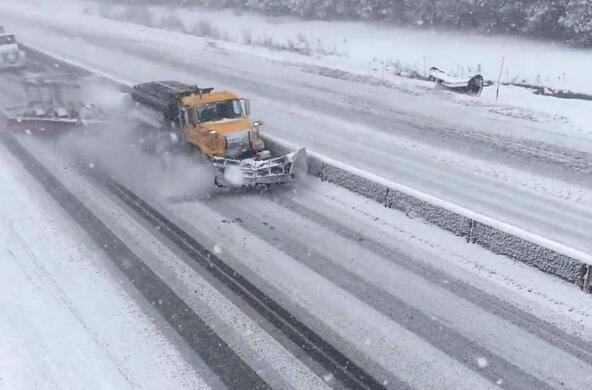With cities across the United States facing one of the most brutal winters in recent memory, the use of road salt can be an economic game changer, one that forces snowy cities to be innovators that balance safety, cost and the environment.
Winter road maintenance swallows 20 percent of state department of transportation maintenance budgets nationally, according to the Federal Highway Administration. State and local agencies spend more than $2.3 billion on snow and ice control operations annually.
So it's no surprise that people like Norman Jones, who works for the third-snowiest large city in the U.S., have spent years experimenting with the best practices for de-icing.
Jones, environmental services commissioner for the city of Rochester, New York, purchases a yearly order of 27,000 tons of salt for de-icing the roads. He budgets more than $1 million more for around-the-clock staff to apply it, December through March. He paid $46.80 per ton for his salt this year, up from $38.30 last year.
He's prepared to keep Rochester up and running, even with more than 100 inches of average snowfall per season. "Our schools have only had one snow day the whole year," Jones said.
The use of road salt has grown controversial for boosting sodium levels in water sources. Some cities, including Boulder, Colorado, and Anchorage, Alaska (the fifth- and sixth-snowiest cities), both switched from salt to magnesium chloride, partially to address environmental concerns, according to their websites.
"Our schools have only had one snow day the whole year."
But that response is far from normal. U.S. salt production rose 9 percent last year as municipalities stockpiled for winter 2015.
With a steep price difference between magnesium chloride ($100-$180 per ton) and salt ($20-$30 per ton, according to research by Cornell University), more and more cities are trying to curb salt use instead of switching.
'Struggling to find supplies'
A January report from the United States Geological Survey (USGS) revealed that salt production was a $2.2 billion industry in 2014, in which 43 percent of all salt sales (about 19 million tons of the 44.1 million tons of salt produced in the U.S.) went to road de-icing. This year's early winter left cities "struggling to find supplies" and avoid last winter's double-digit price spikes. Getting the perfect amount of road salt is a Catch-22: if you wait too long to transport it, the very roads you are trying to clear become impassable to receive salt shipments. But buying it upfront poses its own challenges.
Salt contracts can be subject to 80 percent delivery acceptance rates—meaning that towns must be prepared to pay for 80 percent of the salt they ordered in early autumn, even if it turns out that the salt isn't needed by the time February or March rolls around—and double-digit price increases during shortages, according to USGS. Heavily regulated by antitrust laws, salt producers are tight-lipped on how supply and demand affects their prices, said Lori Roman, president of the Salt Institute, a nonprofit advocacy group for salt.
That doesn't mean that salt is a bad investment. Road salt pays for itself within 25 minutes of being applied, reducing crashes by up to 88 percent, injuries by up to 85 percent and accident costs by up to 85 percent, according to the American Highway Users Alliance, a trade advocacy group in Washington, D.C.
Not buying enough salt can be both dangerous and a huge expense, if impassable roads shut down a city. One day of impassable roads can cost a city up to $300 million-$700 million, depending on the region, said the alliance.
"I know last year, when Atlanta had that thin coat of ice, things shut down for a couple of days, and it's a huge logistic issue," said Bruce Hamilton, director of safety and research programs at the group. "It doesn't take much by way of weather to shut down Atlanta and Texas where they don't already have the salt."
Lost wages are one of the biggest costs of icy roads."In the very unfair sense, the people hit the hardest by unsafe driving conditions are hourly workers who can't get to their jobs and can't get paid," said Hamilton.
But while salt application is both necessary and cost-effective in the correct doses, the long-term costs of oversalting are rarely considered, argue some environmentalists.
More from CNBC: Winter-weary Boston paralyzed after latest storm
Long-term costs
The Cary Institute of Ecosystem Studies, a New York-based independent environmental research team, said that the corrosion and pollution caused by overuse of road salt carries long-term costs. Removing salt from water is especially expensive. The institute conducted a study that found that 60 to 90 percent of salt found in groundwater in Dutchess County, New York, is from road salt. And with that water at twice the Environmental Protection Agency's safe limit of sodium, it's a health concern.
"Anybody with high blood pressure needs to worry about their sodium intake," said Victoria Kelly, who manages environmental monitoring for the Cary Institute.
Some places have tried to tackle environmental concerns in novel ways. Indiana reportedly coated roads with sugar beet molasses last winter, while Wisconsin, according to reports, used leftover cheese brine from dairy farms.
But none of the alternatives are free of environmental concerns, nor do they cut costs. That's why scientists urge salt efficiency, not replacement.
A Cary Institute study found that retrofitting the de-icing trucks in East Fishkill, New York, saved the town $243,810, more than recouping the $140,000 cost.
Other simple tricks like pre-brining roads—the practice of wetting salt with brine to speed its reaction time and prevent it from bouncing off the road—have also increased in popularity in places like Westchester County, New York. Even leaving truck containers less full can take away the temptation for snow fighters to oversalt.Many cities also use more high-tech approaches too, such as road weather information systems, which use Wi-Fi-enabled sensors within the pavement to communicate real-time conditions to monitors at local public works or environmental services offices. A "dashboard" system in Iowa that provides real-time comparisons of how actual salt usage is comparing with recommended target rates was featured as "best practice" by a Federal Highway Administration website.








